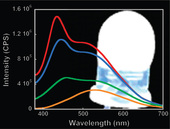Highlight
Inorganic-Organic Hybrid Semiconductors: A New Class of Nanostructured Crystals for Use in White Light-Emitting Diodes
Achievement/Results
IGERT Trainee Mojgan Roushan and IGERT Faculty member Jing Li have demonstrated a new class of hybrid inorganic-organic semiconductors. Their work on the nanoscale material properties of these hybrids has been instrumental in demonstrating their viability for use in white light-emitting diodes, WLEDs. Single-phased white light emitters made of semiconductor bulk materials are most desirable for use in WLEDs based on both photoluminescence and electroluminescence. Li and Roushan’s work has demonstrated that Cd and/or Se substituted double-layer [Zn2S2(ha)] (ha = nhexylamine) hybrid semiconductors emit bright white light in the bulk form and their emission properties are systematically tunable. The ternary Zn2−2xCd2xS2(ha) hybrid compounds exhibit two photoluminescence (PL) emission peaks, one of which being attributed to band gap emission, and the other resulting from Cd doping and surface sites. The Cd concentration modulates the optical absorption edge (band gap) and the positions of the two emission bands along with their relative intensities. The ZnS-based hybrid structures (with a nominal Cd mole fraction x = 0.25) emit bright white light with significantly enhanced photoluminescence quantum yield (PLQY) compared to its CdS-based hybrid analogues. For the quaternary Zn2−2xCd2xS2−2ySe2y(ha) compounds (x = 0.25 and different nominal Se mole fractions y) the synergetic effect between doped Cd and Se atoms leads to further tunability in the band gap and emission spectra, yielding well balanced white light of high quantum yield.
Detailed analysis reveals that the PL emission properties of the ternary and quaternary hybrid semiconductors originate from their unique double-layered nanostructures that combine the strong quantum confinement effect and large number of surface sites. In addition, Li and Roushan have also shown near zero thermal expansion, a rare but desirable material property, in this unique family of inorganic–organic hybrid semiconductors with general formula [ZnSe-(L)0.5] (L = organic diamine) along the layer-stacking axis in the temperature range of 5–300 K. The unit cell parameters and crystal structures of [ZnSe(en)0.5], [ZnSe(pda)0.5], [ZnSe(bda)0.5], and [ZnSe(ptda)0.5] (en = ethylenediamine, pda = propanediamine, bda = butanediamine, and ptda = pentanediamine) have been refined by the Rietveld method by using powder samples, and their thermal expansion properties have been analyzed and rationalized on the basis of their crystal structures and symmetry. [ZnSe(ptda)0.5] features a very small negative linear thermal expansion coefficient (–7.8 10–7 K–1) that approaches the smallest values reported to date. These types of materials are highly desirable, because they are free from thermal shock on rapid heating or cooling, and can prevent the structural instability and mechanical degradation of ceramic materials, in general, resulting from sizable volumetric changes on variation of temperature. Their work on hybrid WLEDs, nanoscale energy-related materials, has been published in many journals including Angewandte-Chemie, Chemistry of Materials and the European Journal of Inorganic Chemistry.
For her work on these materials and other inorganic-organic hybrid semiconductors materials, Prof. Li was awarded a C3E by MIT in Innovation and Technology Development in September 2012.
Address Goals
This activity has the ability to develop the fundamental science that could be the basis for inexpensive white light LEDs. The diverse array of materials that can be accessed by this technology holds tremendous promise for both experimental and fundamental science. The project involved numerous students but the crux of the work was performed by IGERT trainee Mojgan Roushan.








